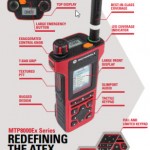Recently released to the Australian marketplace, the TETRA MTP8000EX from Motorola Solutions is an ATEX digital radio developed to provide the safety and high-performance communications necessary in the oil, gas and mining industries.
For more detailed information on these Two Way Radios select TETRA MTP8000EX or call 1800 551 427.
ATEX radios are essential tools for those working in the potentially explosive environments, providing an intrinsically safe Two-Way Radio Communications Solution. The primary function of ATEX radios is to prevent any potential sources of ignition i.e excess heat, sparking. Please note additional considerations should be made regarding the features of these two way radio’s and its suitability to the unique challenges presented in hazardous environments.
Here I look at five key elements of an ATEX radio which are “must haves” in oil and gas operations including refineries, surface and underground mining:
Audio performance – Experiencing high levels of noise is an inescapable part of working in the industry. Constant drilling, heavy machinery, pumps and compressors can see noise levels regularly exceeding 90dB, making clear, loud audio crucial to two-way communications.
The challenge in the design of ATEX radios for operations is driving the speakers to the loudest, clearest possible level without compromising on safety. While the usual solution would be to increase the amount of current driven into the radio, ATEX restrictions means this is not possible.
In addition to this, the unique ambient background noise experienced in heavy industry means not all two way radios will provide the best results. Any radios in use should be optimized for the specific requirements.
Network and radio coverage – Transmission power and receiver sensitivity needs to be maximized to give the best possible coverage. While receiving a signal in the radio will not generally cause any major challenges, it can cause some of the internal components to generate heat, in turn raising the temperature of the radio and increasing the risk of ignition.
Advancements in radio frequency (RF) design have meant higher transmission power can be achieved without raising the temperature of the radio. The challenge is creating a radio that can transmit at the same power levels as non-ATEX radios.
The European Telecommunications Standards Institute (ETSI) standard defines transmit power in “Class” levels. For example, a Class 4 radio has a nominal Tx power of 1W, but the actual definition is 30 dBm +/- 2dB, allowing some design flexibility and manufacturing tolerance. For most modern non-ATEX radios the Tx power is aligned to the higher end of this tolerance, that is, above 1W, however, for ATEX radios the actual measured Tx power of a Class 4 radio is less than 1W – often around 0.7W. This is driven by the need to limit maximum currents in the radio and to limit heating effects.
Rugged for a tough environment – Oil and gas operations can be found in some of the most harsh and unpredictable conditions in the world, so the ATEX radios used must be resilient in the occurrence of extreme heat or extreme cold, as well as exposure to dirt, oil, metal dust and chemicals.
Exposure to multiple water sources is also inescapable, creating a need for radios to provide multiple levels of IP protection, even after thermal cycling, heat shock and drop testing.
ATEX accessories – Having the right accessories for specific environments is a necessity for getting the most from an ATEX radio with remote speaker mics, skull mics, boom mics, noise cancelling headsets, hardhat solutions, smoke diver face masks, earpieces, and large push-to-talk buttons just some of the wide range of accessories used in oil and gas applications.
Usability and ergonomics – As ATEX radios will frequently be used by workers wearing various personal protective equipment (PPE), operation of the radio and its accessories must be optimised for people who may have reduced tactility in their fingers, restricted vision and, as mentioned earlier, work in a loud ambient noise environment.
With many users required to operate from long distances for extended periods of time, the usage of the radio and battery life should extend beyond an average shift of eight hours.
These five key requirements demonstrate the extraordinary technical challenges in delivering communications equipment which not only meets end user needs, but also complies with ATEX and IECEX standards.
Hope you enjoyed this article.
Darrell Tucker
Company Director – Mining Telecommunications Australia

